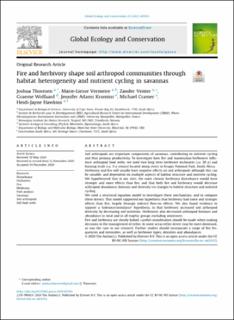Fire and herbivory shape soil arthropod communities through habitat heterogeneity and nutrient cycling in savannas
Thoresen, Joshua; Vermeire, Marie-Liesse; Venter, Zander; Wolfaard, Graeme; Krumins, Jennifer Adams; Cramer, Michael; Hawkins, Heidi-Jayne
Peer reviewed, Journal article
Published version

Åpne
Permanent lenke
https://hdl.handle.net/11250/3037672Utgivelsesdato
2021Metadata
Vis full innførselSamlinger
- Publikasjoner fra CRIStin - NINA [2364]
- Scientific publications [1392]
Sammendrag
Soil arthropods are important components of savannas, contributing to nutrient cycling and thus primary productivity. To investigate how fire and mammalian herbivores influ- ence arthropod food webs, we used two long term herbivore exclosures (ca. 20 y) and burning trials (ca. 5-y return) located along rivers in Kruger National Park, South Africa. Herbivory and fire will usually have negative effects on soil arthropods although this can be variable, and dependent on multiple aspects of habitat structure and nutrient cycling. We hypothesised that in our sites, the more chronic herbivory disturbance would have stronger and more effects than fire, and that both fire and herbivory would decrease arthropod abundance, biomass and diversity via changes to habitat structure and nutrient cycling. We used a structural equation model to investigate these mechanisms, and to compare these drivers. This model supported our hypothesis that herbivory had more and stronger effects than fire, largely through indirect flow-on effects. We also found evidence to support a ‘tolerance/avoidance’ hypothesis, in that herbivory increased soil arthropod diversity by decreasing soil nutrients. Herbivores also decreased arthropod biomass and abundance in total and in all trophic groups excluding omnivores. Fire and herbivory are closely linked, careful consideration should be made when making decisions in the management of either. In some areas either driver may be more dominant, as was the case in our research. Further studies should incorporate a range of fire fre- quencies and intensities, as well as herbivore types, densities and abundances. Disturbance Exclosures Fire Herbivory Path analysis Savannas Soil arthropods Soil food webs
